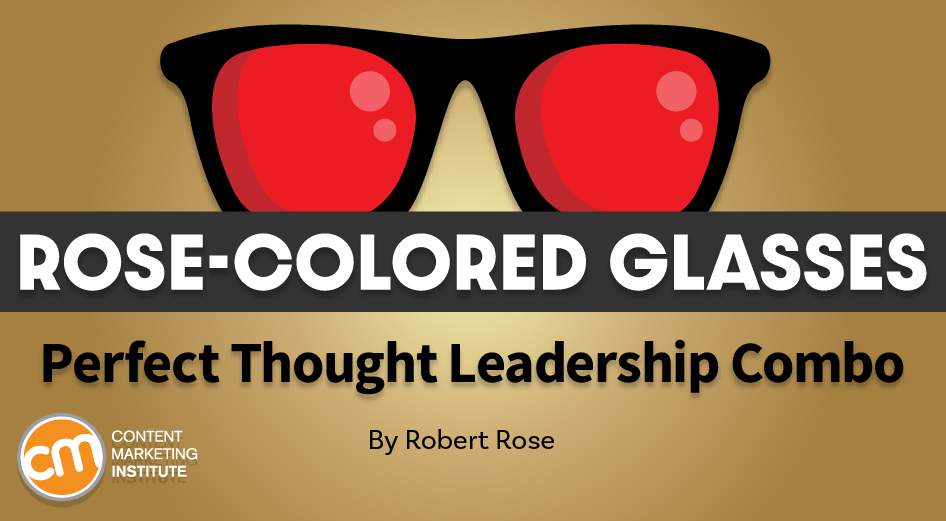One of my favorite motivational speeches happened, of all places, at the Oscars in 2014. The words shared by Matthew McConaughey in his three-minute acceptance speech for best actor can teach you so much.
He spoke of the three things he needs each day – something to look up to, something to look forward to, and someone to chase.
Who he chased surprised me. When he was 15, his hero was who he wanted to be at 25. When he turned 25, his new hero became Matthew at 35. He knew he could never achieve hero status. But he could spend his life trying to become somebody worth chasing.
This wonderful life lesson also works well for content and marketing practitioners.
@McConaughey chases a hero every day – himself in 10 years. It’s a great lesson for #content marketers, says @Robert_Rose via @CMIContent. Click To TweetThe ideal future inspires people to walk the path
Real life is never as tidy, buttoned up, or clean as you think it can or will be.
You’ve probably worked with agencies or consultants at some point in your career. Maybe they helped you choose a new technology, envision a new website, or create a marketing or content strategy. They probably handed you designs, specifications, or plans that made everything seem very doable. The process of doing it might have ended up being messier, harder, or tougher to do than it seemed. But I bet the vision of the ideal future made you want to try to make it real.
The same holds true with thought leadership content. Visionary thought leadership content presents scenarios about futures that might never happen (or might require a messy process to create). Your own organization might not even live up to the ideal.
But the vision of what could be gives your audience something to chase. As Matthew McConaughey might say, it represents the hero – what your audience hopes to be in 10 years.
But I’ve recently seen companies scaling back their visionary thought leadership to focus more on popular and practical content. They pull away from idealistic or futuristic thinking in favor of “how-to” content about current or popular trends.
Companies mistakenly scale back their visionary thought leadership in favor of the more popular and practical, says @Robert_Rose via @CMIContent. Click To TweetArtificial intelligence provides a wonderful example of this. Look at the content that technology companies produce about generative AI. You’ll see a lot of themes such as “how to best use AI in your current marketing” or “top 10 changes you need to make today.”
Those may be good, useful pieces. But I wonder whether the companies have even considered a future that includes generative AI. If I don’t find more visionary content, it feels difficult to trust the depth of their thinking in the practical content.
I understand the reasons for this focus on how-to content. Marketers want to participate in and become the most popular or resonant resource on hot topics. No one wants to be the lone idealist at the party talking about what could be. Rather, they want to be the most popular kid in the school, hip to all the most modern trends, which can help others become hip too. They’re chasing the hero that’s here today.
And every marketer feels the pressure to fill their pipeline with prospects. Often these are people ready to change because they know they need to catch up to today’s standards. People chasing a vision they’re years from achieving may not be ready to talk with sales teams today.
But here’s the problem: What everybody talks about today is rarely where things go.
That’s why it’s a mistake to avoid the visionary.
A content combination to chase
Now, marketers shouldn’t replace their “how-to-do-this-best” content with visionary predictions. You certainly don’t have to abandon your attempts to become the loudest or most resonant voice among the popular ideas. Those are the table stakes for finding people who may align with your worldview.
But help the popular ideas stand out by accompanying them with big, differentiated, or visionary thoughts. If you can be the trusted source of those unique and as yet unexplored thoughts and visions, you bolster the audience’s trust in your more common thought leadership.
In other words, if you help people see the hero (the idealized or visionary thinking) to chase, they’ll trust your recommendations about what to do today even more.
Visionary #content about the future helps audiences trust your recommendations about what to do today, says @Robert_Rose via @CMIContent. Click To TweetThe desire for an idealized future explains why people don’t hold companies and consultants negatively accountable even if they turn out to be wrong about the ideal vision they presented.
People want to chase their future hero. So the consultancy should present the right strategy, not just the one they think the client can easily achieve. The agency should push the creative beyond the bounds of the client’s comfort. Your content team should create thought leadership that describes a future that even your organization aspires to.
So keep creating content for your audience’s future hero. It gives them (and you) something to chase. Neither of you will ever get there. But you’ll always push the possibilities farther than you originally dreamed.
It’s your story. Tell it well.
Get Robert’s take on content marketing industry news in just five minutes:
Watch previous episodes or read the lightly edited transcripts.
HANDPICKED RELATED CONTENT:
Cover image by Joseph Kalinowski/Content Marketing Institute

